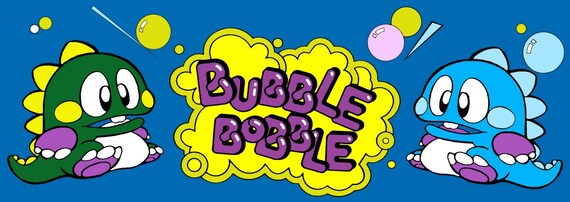General Analysis - XaviFast05/-Calidum-Bullae-Project-1-Bubble-Bobble GitHub Wiki
Page Content

Bubble Bobble cabinet sign
Genre
Bubble Bobble is an arcade platformer game, with action elements. In this combination of genres, we need to use our skills to avoid obstacles while fighting against enemies. Some platformers focus their objectives on going to the end of the level, making the enemies as a simple obstacle, but in this case, to pass the level we need to defeat all the enemies.
A good example of an arcade platformer game, is Donkey Kong, developed and published by Nintendo in 1981

Similar games
- Snow bros was developed and published in 1990 by Toaplan in Japan, then published in North America and Europe by Romstar. Its premise is based on a succession of static screens (50 levels) with different platform designs where you have to shoot enemies until they turn into large snowballs that are later launched bouncing around the screen, dragging and killing other enemies.

- Nightmare in the Dark was developed by AM Factory, with the assistance of Paon, and published by Eleven/Gavaking in 2000. A guardian of graves patrols through graveyards, safeguarding them from evildoers. The player must clear each area, collecting power-ups to eliminate enemies. The game comprises five stages, each consisting of five levels. In each stage, players hurl fireballs at ghouls, ghosts, goblins, and zombies. Similar to Snow Bros., continuously attacking enemies causes them to ignite into larger balls, which players can then use to eliminate other foes. Players must gather the remaining treasure before advancing to the next level.

Technical Profile

Bubble Bobble motherboard
CPU: It employs 2 main processors based on the Zilog Z80 architecture, running at approximately 6 MHz.
RAM: Typically equipped with around 64 KB of RAM for temporary data storage and program execution.
Graphics: It uses a custom graphics card capable of displaying colorful graphics and animated sprites with standard resolution for the time (usually 224x256 pixels).
Sound: It incorporates a dedicated sound chip, such as the Yamaha YM2203, providing polyphonic audio capabilities for sound effects and background music.
Controls: It features a control panel with joysticks and action buttons for players to control the game characters.
Data Storage: It employs storage systems like ROM (Read-Only Memory) to store game code, graphics, and sound data.
Audio/Video Output: It provides standard audio and video outputs to connect to monitors and external speakers.
Coin and Credit System: It incorporates a mechanism to accept coins and assign credits to players to start the game.
History of the game
Bubble Bobble, created by Fukio Mitsuji, a game designer at Taito, aimed to elevate the company's output following Mitsuji's disappointment with their previous games.

Taito logo
Inspired by Namco's titles, Mitsuji developed a platform game with cute characters and a focus on bubbles as the central gameplay mechanic. After brainstorming over 100 ideas, Mitsuji settled on the concept of bubbles, envisioning players popping them in a thrilling manner.
Originally, he considered a robot protagonist but opted for dinosaurs for their cooler appeal. Mitsuji dedicated himself to constantly refining the game, drawing inspiration from Taito's earlier title, Chack'n Pop, and implementing multiple endings to cater to couples. Bubble Bobble was released in Japan in June 1986 and globally later that year, becoming a hit worldwide.
Taito licensed the game for distribution in the United States and Europe, further extending its popularity.
Thanks to the success that Bubble Bobble achieved, it was ported to numerous home consoles like the NES.